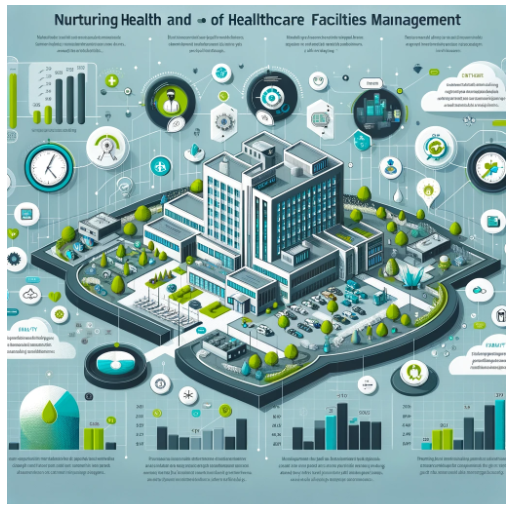Nurturing Health and Efficiency: Unveiling the Essence of Healthcare Facilities Management
I. Introduction
In the intricate web of healthcare operations, the term “Healthcare Facilities Management” stands as a linchpin, orchestrating the symphony of infrastructure, safety, and operational efficiency within medical settings. This article delves into the very essence of Healthcare Facilities Management, deciphering its definition, and unraveling its pivotal role in ensuring seamless operations and the well-being of patients.
Definition of Healthcare Facilities Management
Healthcare Facilities Management encompasses the strategic coordination of physical assets, infrastructure, and support services within healthcare settings. From maintaining the structural integrity of buildings to ensuring compliance with regulatory standards, the scope of Healthcare Facilities Management is vast and multifaceted. It serves as the backbone of healthcare institutions, fostering an environment where both operational excellence and patient care flourish.
II. Key Aspects of Healthcare Facilities Management
In the expansive domain of Healthcare Facilities Management, several key aspects demand unwavering attention to uphold operational efficiency and prioritize patient well-being. This section explores the intricacies of maintenance and infrastructure, regulatory compliance, and the critical aspect of emergency preparedness.
Maintenance and Infrastructure
Maintenance and infrastructure serve as the foundation upon which the delivery of healthcare services rests. Healthcare Facilities Management oversees the upkeep of buildings, equipment, and essential systems, ensuring that everything functions optimally. Regular maintenance not only extends the lifespan of assets but also minimizes downtime, contributing to the continuous flow of medical services.
Regulatory Compliance and Safety Measures
The healthcare landscape is governed by a myriad of regulations and safety standards. Facilities Management plays a pivotal role in ensuring strict adherence to these guidelines. From fire safety protocols to infection control measures, compliance is non-negotiable. By staying abreast of ever-evolving regulations, Facilities Management safeguards the well-being of both patients and staff, creating an environment that prioritizes safety and quality care.
Emergency Preparedness
In the unpredictable realm of healthcare, emergency preparedness is a cornerstone of Facilities Management. From natural disasters to unforeseen medical crises, Facilities Management plans and implements strategies to address emergencies swiftly and effectively. This includes not only physical preparedness but also ensuring that staff is well-trained and protocols are in place to handle any unforeseen challenges.
III. The Role of Technology in Optimizing Facilities Management
In the era of rapid technological advancement, Healthcare Facilities Management embraces innovative solutions to optimize operations and elevate patient care. This section delves into the transformative role of technology, focusing on the adoption of smart technologies and the integration of IoT (Internet of Things) and automation for enhanced efficiency.
Adoption of Smart Technologies
Smart technologies have become indispensable tools in the arsenal of Healthcare Facilities Management. From predictive maintenance systems to intelligent building management, the adoption of smart technologies revolutionizes how healthcare infrastructure is managed. These technologies enable real-time monitoring of equipment and facilities, allowing for proactive identification of potential issues before they escalate.
One of the significant advantages of smart technologies is their ability to enhance energy efficiency. Smart building systems can optimize lighting, heating, and cooling based on real-time usage patterns, contributing to cost savings and environmental sustainability. The adoption of smart technologies not only streamlines Facilities Management processes but also creates an environment that is responsive, efficient, and aligned with the latest advancements.
Integration of IoT and Automation for Efficiency
The integration of IoT and automation takes Facilities Management to new heights of efficiency. IoT devices, ranging from connected medical equipment to smart sensors, gather and transmit data that can be analyzed to inform decision-making. Automation, on the other hand, streamlines repetitive tasks, allowing staff to focus on more complex and critical aspects of healthcare management.
IV. Challenges and Solutions in Healthcare Facilities Management
The dynamic landscape of Healthcare Facilities Management is not without its challenges. This section delves into the hurdles faced in this critical field and explores strategic solutions to address compliance challenges and manage costs effectively.
Addressing Compliance Challenges
One of the primary challenges in Healthcare Facilities Management revolves around navigating the intricate web of compliance regulations. The healthcare industry is subject to stringent standards and regulations governing safety, hygiene, and overall quality of care. Facilities must adhere to guidelines from organizations such as the Joint Commission, the Occupational Safety and Health Administration (OSHA), and various other regulatory bodies.
Addressing compliance challenges requires a multifaceted approach. Regular training programs for staff, robust record-keeping systems, and continuous monitoring of regulatory changes are crucial components of an effective strategy. Collaborating with compliance experts and leveraging technology for real-time compliance tracking are also integral in ensuring that healthcare facilities meet and exceed regulatory requirements.
V. Future Trends in Healthcare Facilities Management
The future of Healthcare Facilities Management is marked by transformative trends that promise to revolutionize the industry. This section explores the impact of artificial intelligence (AI) and predictive analytics and envisions innovations in patient-centric facilities design.
Impact of Artificial Intelligence and Predictive Analytics
Artificial Intelligence (AI) and predictive analytics are poised to be game-changers in Healthcare Facilities Management. AI algorithms can analyze vast datasets to predict equipment failures, optimize maintenance schedules, and enhance overall operational efficiency. Predictive analytics, when integrated into Facilities Management practices, can forecast future trends, allowing for proactive decision-making and resource allocation.
The integration of AI and predictive analytics not only reduces downtime and maintenance costs but also contributes to a more patient-centric healthcare environment. By predicting and preventing potential issues, Facilities Management ensures that critical equipment is operational when needed, minimizing disruptions to patient care.
Innovations in Patient-Centric Facilities Design
The future of healthcare facilities design is focused on creating environments that prioritize the comfort and well-being of patients. Innovations in patient-centric facilities design encompass everything from modular and flexible layouts to the integration of healing gardens and advanced communication technologies.
VI. Conclusion
In the intricate tapestry of healthcare, the role of Healthcare Facilities Management emerges as a linchpin, orchestrating the delicate balance between operational efficiency, patient well-being, and the ever-evolving landscape of regulations and technology. As we recap the insights unveiled in this exploration, it becomes evident that Facilities Management is not merely a behind-the-scenes operation but a crucial force shaping the future of healthcare infrastructure.
Recap of the Crucial Role of Healthcare Facilities Management
Healthcare Facilities Management, with its multifaceted responsibilities spanning maintenance, compliance, and emergency preparedness, is the backbone of healthcare institutions. From ensuring the structural integrity of buildings to navigating complex compliance regulations, Facilities Management is instrumental in creating an environment where both staff and patients thrive. The importance of addressing challenges, adopting sustainable practices, and embracing technological advancements underscores the pivotal role that Facilities Management plays in the seamless functioning of healthcare facilities.
In this concluding chapter, we extend an invitation to all stakeholders in healthcare to unite in the pursuit of a future where Facilities Management is not only a necessity but a driving force behind a healthcare ecosystem that is technologically advanced, environmentally responsible, and centered around the well-being of every individual it serves. Together, let us forge a path towards a healthcare future that embodies efficiency, sustainability, and compassion.


